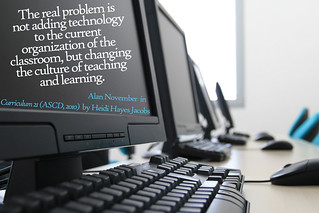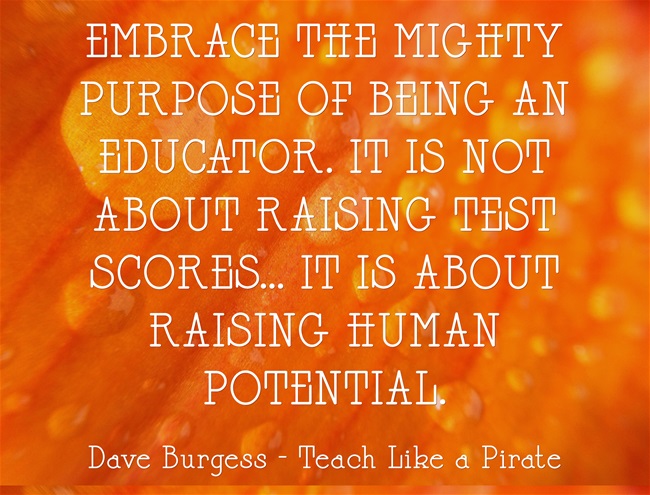According to the definition on the Cornell University website, digital literacy is the ability to find, evaluate, utilize, share, and create content using information technologies and the Internet. If used correctly, digital literacy enables students to think critically about information and communication as citizens of the global community while using technology responsibly and ethically. It will eventually help them become life-long learners who have internalized the fact that learning can take place anywhere at any ...
Digital Literacy has 3 important components:
• Technology Literacy
• Information Literacy
• Digital Citizenship
I had originally planned to write about digital literacies in one post but it became such a long post that I decided to write about information literacy and digital citizenship in another post. I know there are too many links in this post but updating curriculum to transform learning requires a lot of reading and research to be able to do it effectively. Transforming education is not an easy process. I strongly believe that before transforming our schools and our curriculum, we need to transform ourselves as educators and know the reasons why there is a need for such a transformation as well as how to do it.
Technology Literacy
Our students should develop proficiency and fluency with the tools of technology as active and successful participants of the 21s century global society. This will allow us to personalize learning effectively and fully immerse them in content that is interactive, relevant and authentic; thus, making learning fun and improving student motivation and engagement. The important point to keep in mind is the fact that tech integration is not about technology, it is about learning. Otherwise, adding technology to our curriculum, without changing the way we teach, will take us nowhere.

https://www.flickr.com/photos/langwitches/4369233394
Image source: Langwitches on Flickr
TIPS FOR EFFECTIVE TECH INTEGRATION:
• Use technology for discovery, accessing opportunity, documenting and sharing learning, showcasing achievements and reviewing/reflecting on learning. If used correctly, technology can give every student a voice and help make student thinking and understanding visible, enabling them to communicate and collaborate with others in and out of the classroom to find solutions to problems, to construct knowledge, to create content, to share their learning or to get and give feedback. The aim is to enable the students have the control over their learning by making choices about what to learn and how to learn it at their own pace by using higher order thinking skills and practicing effective communication and collaboration skills. In such a learning environment, the teacher is the coach rather than the expert and the authority in the classroom. Instead of focusing on delivering knowledge, the teacher provides scaffolding to help students develop higher order thinking skills and deeper understanding.
• In our tech and information-infused, rapidly changing world, teachers are not expected to have all the answers. The teacher is a learner, too; so, don’t be afraid of using technology if you feel that your students are better at it than you are. Instead, empower them by making them the tech leaders of your class. Let your students be in the driver seat and make sure that your relationship with your learners is based on trust and openness rather than power and control.
• Technology will give you endless opportunities to personalize learning. Address and respect your learners’ gifts and struggles appropriately by utilizing technology to ensure that each learner feels a part of your learning community. Give them freedom to discover and develop their own passions and interests to boost their engagement.
• Make sure that learning doesn’t only come from books but from experience as well. Since you cannot be an expert at everything, let your students connect to experts all over the world to find the answers they are looking for or to learn new things. Imagine how excited your students will be if they get connected with the author of the book they are reading or someone from NASA if they are learning about space. You can also take them to virtual field trips and bring the world into your classroom.
• Using technology in the classroom may sometimes mean making mistakes and failing. Instead of avoiding using tech in your classroom because of that, use it to show your students that making mistakes and failing are important parts of learning and can be used as an opportunity to grow on the way to success.
• Help your students become creators rather than consumers of technology. Make sure that your students know creation literacy skills so that they can effectively create information. Provide them with opportunities to self-publish and share their work.
• As learners learn best when they create, share, and teach others, have your students use screencasting tools to create meaningful learning experiences. Model your students by screencasting yourself to flip parts of your curriculum.
• Technology will also help you make formative assessment a routine in your classroom to support learning. Make sure that there is ongoing formative assessment in your classroom as a seamless part of the classroom culture. There are great tech tools that will help you do this. You can use backchanneling tools to get immediate feedback, ask your students to create video projects, or podcasts to review the lesson, use digital exit tickets or QR codes for reflection activities and give them feedback on their work. Teachers whose students don’t have or are not allowed to use electronic devices in the classroom can use Plickers.
Here you can see an end-of-the-year reflection assignment prepared for our 11th graders who took an IELTS preparation course. This was a two-hour elective chosen by some of our students who were preparing for the IELTS exam. Because it was a mixed-ability class, we designed a class blog to cater the needs of different types of learners with different levels of English. By clicking the links under the Useful Links tab, students were able to choose the tasks according to their needs and do them at their own pace. Some students were going to take TOEFL or SAT instead of IELTS, so we added links for them as well. As this was an elective course, students who didn’t take this course but were going to take IELTS had access to the blog as well. Without the help of technology, it would have been impossible for us to do all these in such a practical way both for the teacher and the students.
• So, how are you going to integrate all these skills into your literacy curriculum? Teach-Learn-Lead is a digital edu-library where you can find a wealth of resources for your PLN. Please keep it on your desktop or Dropbox because you will refer to it a lot if you are planning to update your curriculum. This valuable resource was curated by my Twitter friend, Dean J. Fusto. Even though we have never met personally, we have stayed connected via social media and have learned many things from each other via sharing.
• Before you start designing your new curriculum, you can analyze NCTE’s framework for 21st Century Curriculum and Assessment, Curriculum 21, Education 2020 Wiki, ISTE standards, and ISTE Standards Implementation Wiki as a starting point. You may also check the questions in this post.
• For effective tech integration, WebTools4U2Use Wiki, 21 Things 4 Teachers, 101 Free Tech tools for Teachers, Apps for Education, 40 Free Mobile Apps, and Hidden Gems may be helpful. Shelly Terrell’s website is a treasure for teachers. You can also visit websites like Curriculum21 Clearinghouse and Graphite to find teacher reviewed apps, games, and websites.
• Using Google Apps for Education is a practical way to share resources with your students. They are great for classroom and school-wide collaboration. You can find what other things you can do with Google Classroom in this blog post and how you can use it in this comprehensive guide.
• Please note that all these tools have been listed for you to choose the ones to support your curricular goals and learning objectives. Otherwise, there is no point in using them. Make sure that your digital curriculum includes tech that improves the learning process. After all, digital literacy is more about enhancing learning than using tech tools. In this blog post a first grade teacher writes about how technology has transformed her teaching.
• Having proficiency and fluency in using tech tools not only means knowing how to use them but also when and why to use each tool to achieve the desired outcome. Therefore, instead of telling your students which tool to use for a specific task, give them a list of tools to choose from. For this purpose, you can use curation tools like Pinterest, Scoop.it, Symbaloo, List.ly, and Edshelf. You can also share websites like Web Tools for Kids and wikis like Cool Tools for Schools with your students. Let them find, evaluate and use apps that match with the work they are doing and take risks and try new things with them.
As Heidi Hayes Jacobs says, “As times change, so must our curriculum. Start small by learning one new tool a month or making one curriculum upgrade a month. Your students will love you for it, but even better than that you will be sending them out of your class with tools they need to be successful RIGHT NOW – not in the future!”

Comment
© 2025 Created by Steve Hargadon.
Powered by
![]()
You need to be a member of Classroom 2.0 to add comments!
Join Classroom 2.0